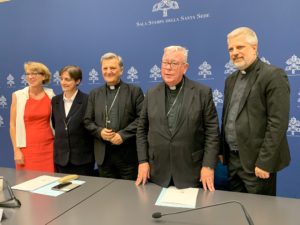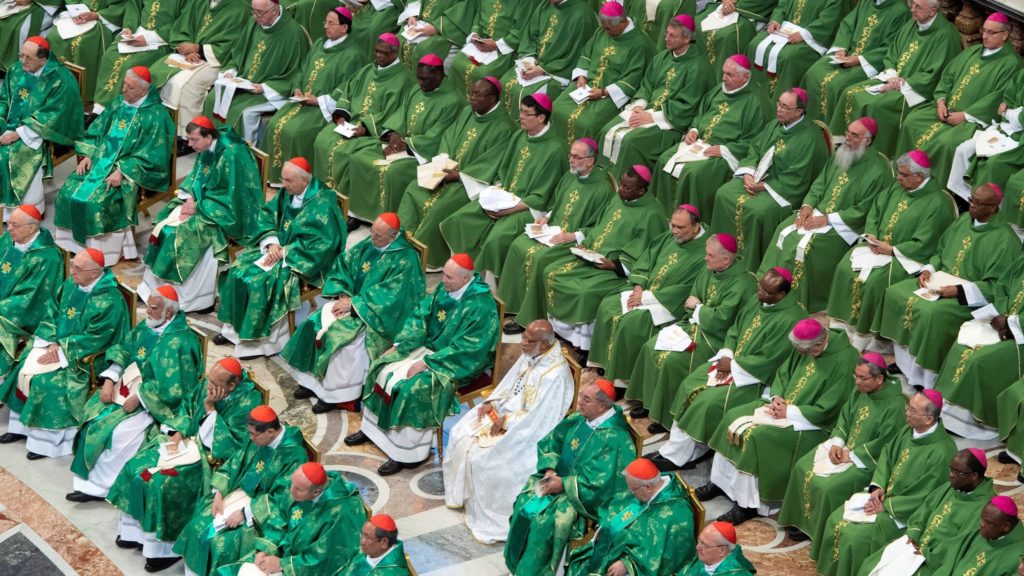Touting the process as an effort to lead global Catholicism “beyond fragmentation and polarization,” the Vatican published Tuesday the Instrumentum laboris, or “working document,” for a Synod of Bishops on Synodality convened by Pope Francis in October.
However, the specific issues the document lists as matters to be addressed during the summit may actually fuel the Church’s divisions by seeming to favor liberal concerns.
Among the specific topics for discussion the document lists are the ordination of women as deacons and married men as priests, as well as greater outreach to LGBTQ+ Catholics and a focus on the poor, the environment and immigration.
On the other hand, the nearly 27,000-word document does not suggest discussion of abortion, same-sex marriage or euthanasia, all typical priorities of more conservative Catholics – indeed, the words “abortion” and “euthanasia” never appear in the text, and “marriage” is mentioned only three times, in the context of remarried divorcees and how to handle inter-church and polygamous marriages.
Although the text stipulates it is “not a document of the church’s magisterium,” meaning its teaching authority, the preponderance of what are often considered progressive Catholic topics nevertheless may further alienate conservatives.
Formally opened by Pope Francis in October 2021, the Synod of Bishops on Synodality is officially titled, “For a Synodal Church: Communion, Participation, Mission,” and is a multi-stage process that will culminate in two Rome-based gatherings in October of this year and October 2024.
Though still difficult for many to define, “synodality” is generally understood to refer to a collaborative and consultative style of management in which all members, clerical and lay, participate in making decisions about the Church’s life and mission.
From Oct. 4-29, bishops and select delegates, including laypeople, will gather in Rome for the first of a two-part discussion, which will close with a similar gathering in October 2024.
After an initial consultation with laypeople at the diocesan level, reports summarizing the conclusions were sent to national bishops’ conferences and a document was drafted as the basis of reflection for the continental stage of the synod.
During this time, a so-called “Digital Synod” also unfolded, with discussion groups and engagement online. A final report from the digital synod was submitted along with the reports from the continental assemblies.
The final reports of those continental assemblies were the primary points of reference in drafting the synod’s Instrumentum laboris.
The aim of the document, according to its foreword, is “to continue to animate the synodal process in the ordinary life of the Church, identifying which pathways the Spirit invites us to walk along more decisively as one People of God.”

One of the biggest questions the document seeks to address is how the Church can “walk together” amid modern challenges and differences of opinion.
“We have discovered that there are shared questions, even if synodality is experienced and understood in a variety of ways in different parts of the world on the basis of a common inheritance of the apostolic Tradition,” the document said, saying part of synodality, then, “is to discern the level at which it is most appropriate to address each question.”
“Equally shared are certain tensions,” the document said, insisting that “We should not be frightened by them, nor attempt at any cost to resolve them, but rather engage in ongoing synodal discernment. Only in this way can these tensions become sources of energy and not lapse into destructive polarizations.”
It stressed the need to achieve “perfect communion” in the Church, regardless of “all the differences that compose it, differences which are maintained and united in the one mission that remains to be completed,” which is to worship Christ.
However, achieving this communion is no easy task, especially when the document could be perceived as falling short of engaging issues important to a significant contingent of global Catholicism, notably those who do not share much of Pope Francis’s pastoral vision and agenda.
For example, while the document refers to the “the inculturation of the liturgy,” meaning adaptation to local traditions and customs, it does not mention debates over the Traditional Latin Mass, which have become a lightning rod in some Catholic circles.
In fact, “Latin” generally is only mentioned in reference to Eastern Catholic Churches and their relationship with the Latin, meaning Western, Church.
The document highlighted liturgy as the place where Catholics ought to gather in unity, yet the lack of any mention of the debate of the Traditional Latin Mass restrictions is noteworthy, as ongoing liturgical tensions, including divisions over Pope Francis’s suppression of the Latin Mass, were included in the document for the continental assembly.
The word “women” is mentioned 45 times in the document, mostly in reference to the failure to properly recognize and value the contribution of women in the church, while calling for the facilitation of their increased participation, including in decision-making and governance roles.
Worksheets with discussion topics included questions such as, “What new ministries could be created to provide the means and opportunities for women’s effective participation in discernment and decision-making bodies?”
To this end, the document noted that most continental assemblies asked that “the question of women’s inclusion in the diaconate to be considered,” and suggested a discussion question of, “Is it possible to envisage this, and in what way?”
Yet despite the heavy focus the document places on the role of women in the church, the word “mother” does not appear once, apart from references to the Virgin Mary.
Likewise, the word “family” only appears a handful of times, and always in reference to the “family of God” or the entire “human family.”
The document, while failing to offer specifics, did however offer a veiled reference to ongoing debates over divorced and remarried couples and the so-called “liturgy wars.”
In its introduction, the document noted that during the consultation process, questions emerged “on which there is already magisterial and theological teaching to be considered.”
To this end, they pointed to Pope Francis’s 2016 post-synodal exhortation on the family Amoris Laetitia, during which he, in a footnote, opened a cautious door to communion for remarried divorcees, and to the 1994 instruction Varietates legitimae on inculturation of the liturgy.
“The fact that questions continue to emerge on issues like these should not be hastily dismissed, rather, it calls for discernment, and the Synodal Assembly is a privileged forum for so doing,” the document said, saying, “the obstacles, real or perceived, that have prevented the steps indicated by previous documents from being realized should be considered and reflections offered on how they can be removed.”
If the inability to accept magisterial documents comes from a lack of information, then “improved communication will be needed,” it said. However, if it is due to difficulty “grasping the implications of the documents” or an “inability of persons to recognize themselves in what is proposed,” then a synodal journey “of effective reception” is likely “the appropriate response,” it said.
Mention of the abuse crisis was also mentioned, with the recognition that “learning to exercise justice as a form of care for those who have been wounded by members of the Church.”
Various forms of abuse within the church are “open wounds, the consequences of which have yet to be fully addressed,” the document said, saying, “To the penitence it owes to victims and survivors for the suffering it has caused, the Church must add a growing and intensified commitment to conversion and reform in order to prevent similar situations from happening again in the future.”
According to the document, it will not be able to produce “conclusive guidelines” on the many issues addressed in just one session, which is why a second Rome gathering is taking place in October 2024.
The aim of this year’s discussion is to “outline paths of in-depth study,” with the goal of identifying the “relevant actors” involved and to ensure that “a fruitful process in service to the discernment to be completed in the second session in October 2024” be carried out.

